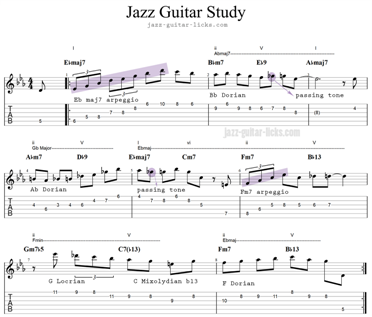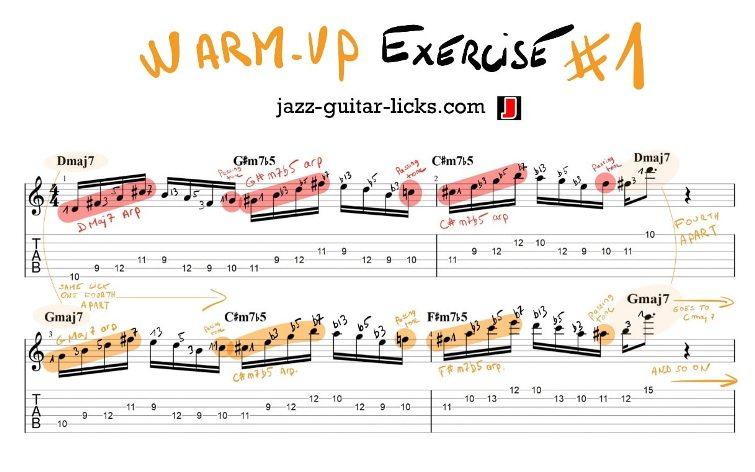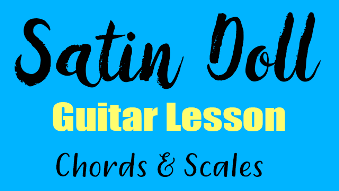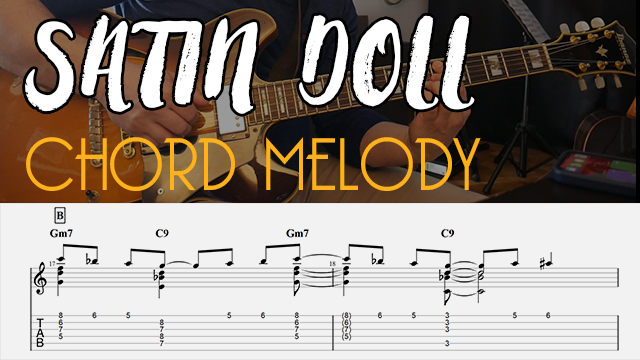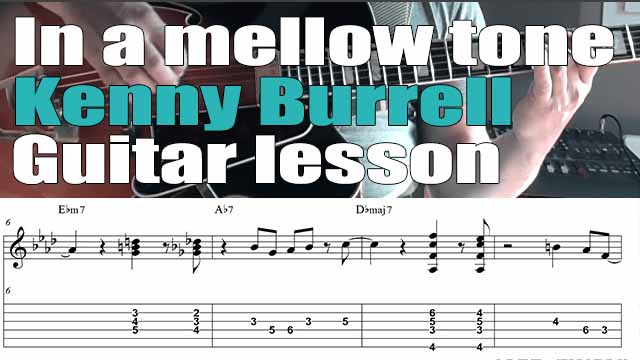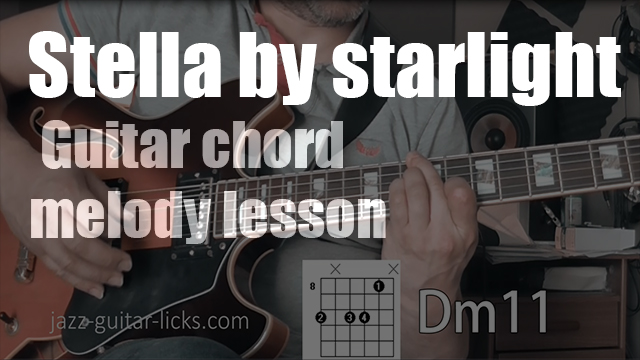jazz guitar lesson
-
Jazz Guitar Phrases Over Common Changes - II V I and I VI II V - PDF With Tab, Shapes and Video (part 1)
- By jazz-guitar-licks
- On 2021-11-09
- In Jazz Guitar Lessons
- 0 comments
This short jazz guitar study with tab, score and chord charts provides some easy jazz lines to apply over three common chord progressions found in jazz. These licks will help you better understand what scales and modes can be used over basic chord changes. You'll find a link to the free PDF at the end of this lesson.
-
Warm-up Exercise For Guitar - Seventh Arpeggios
- By jazz-guitar-licks
- On 2021-08-11
- 3 comments
This warm-up exercise for guitar is to repeat a melodic line following the cycle of fourths. This line is made of two bars containing a major seventh arpeggio (1 - 3 - 5 - 7) and two half-diminished arpeggios (1 - b3 - b5 - b7).
-
Satin Doll - Chords and Scales For Guitar - Lesson For Beginners
- By jazz-guitar-licks
- On 2021-03-22
- In Jazz Standards
- 0 comments
Satin Doll by Duke Ellington and Billy Strayhorn, witten in 1953, is one of the most famous jazz tune. It has been recorded by many jazz musicians as Wes Montgomery, Ella Fitzgerald, Mc Coy Tyner, Oscar Peterson and of course Duke Ellington himself. It has become a classic jazz standard, a must-hear, very popular at jam sessions.
This guitar lesson with chord shapes and scale charts explains how to play easy jazz chords and what basic scales to choose for improvising over Satin Doll.
-
Satin Doll Arranged For Jazz Guitar - Video With Tabs
- By jazz-guitar-licks
- On 2021-03-15
- 0 comments
Check out the latest video from the YouTube channel. This is a chord melody arrangement for guitar of Duke Ellington's jazz standard "Satin Doll".
This free lesson with tabs is intended for intermediate players who want to practice some drop 2, drop 3 voicings, walking bass lines, chords inversions and substitutions over one of the most popular jazz tune.
-
Kenny Burrell - Midnight Blue - Part 1 - Guitar Lesson With TAB - Steve Down - Creator Spotlight
- By jazz-guitar-licks
- On 2020-08-20
- In Teacher Spotlight - Jazz Guitar Lessons
- 0 comments
Lesson By Steve Down
I'm super excited to start my new lesson series on one of my favourites 'Midnight Blue' by Kenny Burrell. If you love blues and are looking to dip your toe into jazz then this is a great place to start! Have fun!
PART 1 This is a new series where we are learning the whole of Kenny Burrell's 'Midnight Blue' from his 1963 album of the same name. There will be a new lesson every Saturday where we will learn another chorus from this excellent tune! And there will be TAB on screen!
In this lesson we look at the head of Midnight Blue. The chords, the melody and some of the gear KENNY BURRELL used for the Midnight Blue recording sessions. Next week we will be looking at the first chorus from the solo!
-
Creator Spotlight - Twelve Tone Box - Sound Bite #7 - Bb Major - Pedro Velasco
- By jazz-guitar-licks
- On 2020-08-20
- In Teacher Spotlight - Jazz Guitar Lessons
- 0 comments
Lesson by Pedro Velasco,
Here's number 7 from the Sound Bite series. Next one on Friday.
In this sound bite series I create short chord progressions and melodic motifs over common jazz chord changes. Check the transcription after the video.
For more sound bites and transcriptions,
go to my YouTube channel:
https://www.youtube.com/user/pedrovpeters
or Soundslice page:
https://www.soundslice.com/users/pedrovelascomusic/Thanks!
-
Jazz Guitar Method - PDF eBook - 40 Dominant (Mixolydian) Guitar Licks
- By jazz-guitar-licks
- On 2020-01-27
- In Jazz Guitar Lessons
- 0 comments
A brand new PDF method is available for download. It rounds out the two previous eBooks Ionian jazz guitar licks and Dorian jazz guitar licks. This book contains 40 dominant jazz guitar lines with tabs, audio files and theory based on the Mixolydian mode for beginners and intermediate players.
Package Details:
- 1 Printable PDF file (high resolution).
- 40 MP3 Audio files related to each lick (high quality).
- 1 Jazz backing track.
-
How to Practice Pentatonic Scales On Guitar
- By jazz-guitar-licks
- On 2019-06-01
- 0 comments
Pentatonic scales are scales with five notes per octave. They are frequently used in music all over the world. The word "pentatonic" comes from the Greek word "pente" meaning five and "tonic" meaning tone.
Talk of "the" pentatonic scale generally make reference to the major pentatonic scale and its relative minor. It's a mistake, indeed there are many types of pentatonic scales (Egyptian, Ritusen, Man gong, Altered, Locrian...).
Pentatonic scales are considered earlier than heptatonic scales (seven-note scales) and can be divided into two categories :
- Containing semitones (hemitonic)
- Without semitones (anhemitonic)
The purpose of this post is to propose some tips and ideas for practicing and develop pentatonic scales.
-
Harmonized Major Scale For Guitarists With Shapes
- By jazz-guitar-licks
- On 2018-04-27
- In Infographics
- 0 comments
This infographic with three neck diagrams is a useful reminder for beginner guitarists and composers. It shows how to build a drop 2 seventh chord from each note of the major scale.
-
Melodic Minor Scale Exercises For Guitar – Position Shifts
- By jazz-guitar-licks
- On 2018-01-14
- In Scales & Arpeggios
- 0 comments
Learning and playing scales can be an important part of any guitarist’s practise regime.
By playing scales in a variety of ways we can develop our familiarity with the fretboard beyond simply going up and down scales.
In this tutorial we will look at combining two different scale patterns by shifting between them on various strings.
For this we are going to use two patterns of an Eb Melodic minor scale, patterns 2 and 3.
The Melodic minor scale consists of the intervals R 2 b3 4 5 6 7 (R is for the Root note).
-
The Blues Arpeggio - How To Mix Major And Minor Triads
- By jazz-guitar-licks
- On 2017-11-17
- In Jazz Guitar Lessons
- 0 comments
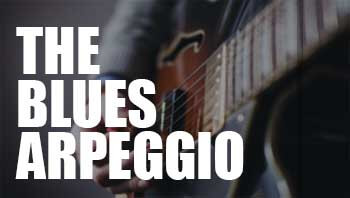 What's the Blues Arpeggio ?
What's the Blues Arpeggio ?Traditionally, when a student learns to improvise over a jazz, blues tune, he taught pentatonic scales, major triads or dominant 7th arpeggios, but there is something missing to get this specific and exciting jazz-blues sound, "The Blues Arpeggio". This is a very interesting and important device to use over this musical genre. It is a mix of a major triad and a minor triad, it contains both major and minor thirds, representing one of the most vital elements of the blues. In this jazz guitar lesson we will see how to build the blues arpeggio, how to practice it and how to play it on a blues.
-
Kenny Burrell - In a Mellow Tone - Jazz Guitar Transcription
- By jazz-guitar-licks
- On 2017-09-21
- 0 comments
A new video has been uploaded on the youtube channel. It is a jazz guitar transcription of the jazz standard "In a mellow tone" composed by Duke Ellington and performed by Kenny Burrell in 1990.
Here is the Kenny Burrell version on which the transcription is based and the link to the album dedicated to Duke Ellington.
-
Jazz Up Basic Guitar Chords - Guitar Lesson for Beginners
- By jazz-guitar-licks
- On 2017-04-27
- In Guitar Practice Tips
- 2 comments
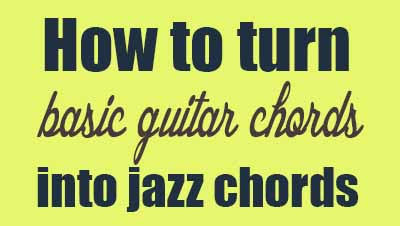 Generally, when a beginner start to learn to play guitar, he tackles open chords (up the guitar neck), those found in many popular songs.
Generally, when a beginner start to learn to play guitar, he tackles open chords (up the guitar neck), those found in many popular songs.Then, come the bar chords (major, minor, dominant 7) a little hard to master. But all these chords do not have a very interesting sound and are not mostly used in jazz music.
That's why in this lesson for jazz beginners we will take the main basic guitar bar chords to transform and enrich them so that their sonority is richer, exciting and better suited to jazz concept.
-
The Tritone Substitution - Guitar Lesson With Theory and Tabs
- By jazz-guitar-licks
- On 2017-04-13
- 2 comments
The tritone substitution sometimes referred to as dominant chord substitution is one of the most popular harmonic technique found in jazz and other styles of music.
It involves replacing a dominant seventh chord with another dominant seventh chord located a tritone (or augmented fourth) away from the original chord's root.
-
Stella by Starlight - Jazz guitar chord melody lesson
- By jazz-guitar-licks
- On 2017-04-11
- 1 comments
A new video is online on the youtube channel. It is a quick jazz guitar chord melody arrangement with chord diagrams of the famous jazz standard "Stella by Starlight" (Victor Young).
-
What's a Half-Diminished Chord (m7b5)
- By jazz-guitar-licks
- On 2017-04-07
- 2 comments
This guitar lesson explains what is m7b5 chord, how to play it on guitar and how to apply it in common harmonic contexts as major and minor II-V-I progressions.
